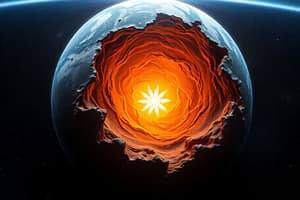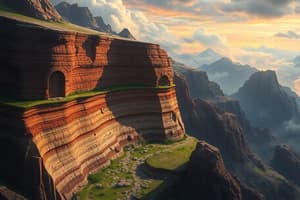Podcast
Questions and Answers
Which layer of the Earth has the highest density and what is its value?
Which layer of the Earth has the highest density and what is its value?
- Continental Crust, 2.9 g/cm^3
- Outer Core, 9.9 g/cm^3
- Mantle, 5.6 g/cm^3
- Inner Core, 12.8 g/cm^3 (correct)
What is the main heat transfer method in geothermal energy?
What is the main heat transfer method in geothermal energy?
- Evaporation
- Radiation
- Conduction
- Convection (correct)
What is the maximum depth of the outer core layer of the Earth?
What is the maximum depth of the outer core layer of the Earth?
- 2900 km
- 6378 km
- 5150 km (correct)
- 5050 km
How does the temperature of the outer core compare to that of the mantle?
How does the temperature of the outer core compare to that of the mantle?
Which type of igneous rock melts at lower temperatures?
Which type of igneous rock melts at lower temperatures?
What are the two main sources of geothermal heat?
What are the two main sources of geothermal heat?
How do seismic waves help scientists infer the characteristics of each layer of the Earth?
How do seismic waves help scientists infer the characteristics of each layer of the Earth?
Which mineral is most commonly associated with granite?
Which mineral is most commonly associated with granite?
Flashcards
Seismology
Seismology
The study of earthquakes and the structure of the Earth's interior using seismic waves.
How Seismic Waves Help Us
How Seismic Waves Help Us
Seismic waves travel at different speeds through different materials. Waves speed up in denser materials and slow down in less dense materials. These changes in speed help scientists infer the composition and physical states of Earth's layers.
Geothermal Energy
Geothermal Energy
The heat energy generated by the Earth's internal processes, such as radioactive decay and the heat left over from Earth's formation.
Convection in Geothermal Energy
Convection in Geothermal Energy
Signup and view all the flashcards
Inner vs. Outer Core
Inner vs. Outer Core
Signup and view all the flashcards
Earth's Magnetic Field
Earth's Magnetic Field
Signup and view all the flashcards
Mineral Crystallization Order
Mineral Crystallization Order
Signup and view all the flashcards
The Rock Cycle
The Rock Cycle
Signup and view all the flashcards
Study Notes
Earth's Interior Layers
- Oceanic Crust: Depth 5-15 km, Density 2.7-2.9 g/cm³.
- Continental Crust: Depth 30-50 km, Density 3.4-5.6 g/cm³.
- Mantle: Depth 2900 km, Density 3.3-5.6 g/cm³.
- Outer Core: Depth 5150 km, Density 9.9-12.2 g/cm³.
- Inner Core: Depth 6378 km, Density 12.8-13.1 g/cm³.
Seismic Waves and Earth's Interior
- Seismic waves' behavior reveals layer characteristics.
- Variations in wave speed and direction reveal density, composition, and state of matter within the layers.
Geothermal Energy
- Geothermal energy originates from Earth's internal heat.
Geothermal Heat Sources
- Radioactive decay of elements in Earth's interior is a primary heat source.
- Heat left over from Earth's formation is another source.
Earth's Magnetic Field and Outer Core
- Liquid outer core movement generates a magnetic field.
- Convection currents in the liquid outer core cause electrical currents, creating the field.
Earth's Inner and Outer Core: Comparison
- Inner core: solid iron and nickel, extremely dense.
- Outer core: liquid iron and nickel, less dense than inner core.
Thermal Convection and Earth's Interior
- Differences in temperature and density in Earth's layers drive thermal convection.
- Convection currents in the mantle affect tectonic plate movement.
Thermal Convection in Earth's Interior (cont.)
- Crust: Depth (0-35 km), Composition (silicate rocks), Density (2.7 g/cm³), Temperature (0-400°C).
- Mantle: Depth (35-2900 km), Composition (peridotite), Density (3.3-5.6 g/cm³), Temperature (500-4000°C).
- Outer Core: Depth (2900-5100 km), Composition (liquid iron and nickel), Density (9.0-12.0 g/cm³), Temperature (4000-6000°C).
- Inner Core: Depth (5100-6371 km), Composition (solid iron and nickel), Density (12.8-13.1 g/cm³), Temperature (5000-6000°C).
Earth's Layers: Density
- The inner core has the highest density: 12.8-13.1g/cm³.
Outer Core vs Mantle: Temperature
- Outer core is hotter than mantle.
- High temperatures of the outer core affect convection in the mantle.
Inner Core Composition and Convection
- Inner core's composition (iron and nickel) contributes to overall thermal convection.
Rock Cycle and Minerals
- Mineral crystallization sequence in magma: Higher-melting-point minerals are first to crystallize, while minerals with lower melting temperatures crystallize later.
- Ultramafic Igneous Rocks Ultramafic rocks are rich in ultramafic minerals that contain low percentages of silica.
Igneous Rock Types
- Basalt: Mafic composition, melting point (1000-1200°C), minerals (olivine, pyroxene).
- Andesite: Intermediate composition, melting point (800-1000°C), minerals (plagioclase, amphibole).
- Granite: Felsic composition, melting point (600-800°C), minerals (quartz, feldspar).
- Rhyolite: Felsic composition, melting point (650-800°C), minerals (quartz, feldspar).
- Diorite: Intermediate composition, melting point (800-900°C), minerals (plagioclase, biotite).
Igneous Rock Melting Points
- Granite generally has the highest melting point amongst listed types.
Studying That Suits You
Use AI to generate personalized quizzes and flashcards to suit your learning preferences.




